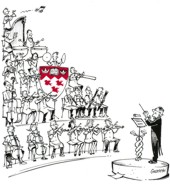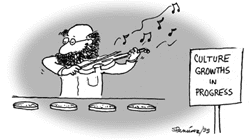Symposium at the 4th Annual Meeting of the Canadian Association for Neuroscience
Ottawa, ON, May 18, 2010
Title:
Neurobiology of music
Chair:
Ante L. Padjen
Department of Pharmacology & Therapeutics, Director and founder, I Medici di McGill Orchestra
McGill University, 3655 Prom Sir-William-Osler, Suite 1316, Montréal, QC H3G 1Y6; ante.padjen@mcgill.ca, http://www.imedici.mcgill.ca
Abstract:
Together with language music is a uniquely human characteristic. The interest in studies of biological correlates of music is relatively recent with the surge driven largely by the technological advances in the studies of human brain and by the development of new conceptual frameworks. Some 1000 studies published since the year 2000 identified a range of topics that are defining the domain, e.g. modular nature of music processing, music vs language processing, brain localization, innateness and development of musical capacity, emotional correlates of music processing, neurophysiological correlates of music performance, etc.
The purpose of the symposium / workshop is to provide an update on several major themes by three expert speakers. Enough time will be provided for discussion with an attempt to examine the possible common conceptual bases of the biological foundations of music.
Speaker 1
Laurel L. Trainor
Director, McMaster Institute for Music and the Mind, Professor, Psychology, Neuroscience & Behaviour
McMaster University, ljt@mcmaster.ca, http://psycserv.mcmaster.ca/ljt/
Title:
Development of musical perception
Abstract
Objectives
To examine the effects of musical training on brain development in infants and young children.
Experimental Approaches and Results
We will begin by presenting EEG and MEG data showing that brain responses differ between adult musicians and non-musicians in terms of event-related potentials for encoding isolated tones, single melodies, and polyphonic melodies. We will show that these groups also differ in terms of gamma band responses that reflect attention, memory and top-down processing. We will then show that these differences can already be seen in preschool children taking music lessons compared to children not training musically. Finally, we will present data showing after 6 months of participation in music classes for infants between 6 and 12 months of age, those infants randomly assigned to active participatory classes show more mature brain responses to sound than those infants randomly assigned to a passive listening class.
Conclusion
Music experience has a large effect on brain development in early
Speaker 2
Robert J. Zatorre
Montreal Neurological Institute, McGill University
Co-director of BRAHMS (International Laboratory for BRAin, Music and Sound Research), James McGill Professor, McGill University, Montréal, QC, robert.zatorre@mcgill.ca; http://www.brams.org/
Title:
Analysis of Musical Pitch: Functional Pathways and Structural Correlates
Abstract:
In this lecture we will consider functional and structural neuroimaging findings dealing with the organization of the human auditory cortex for the processing of complex acoustic signals. We focus on the processing of pitch patterns, how this processing change as a function of experience, and the interactions between auditory and parietal cortical systems involved in higher-order aspects of pitch processing. We will start by examining the evidence for specialization of auditory cortex for the analysis of pitch, reviewing converging evidence that a region in the right lateral Heschl’s gyrus plays a particularly important role in the representation of pitch. We will then consider how musical training interacts with the organization of this pitch-processing system. Our evidence suggests not only that training has consequences on anatomy and function, but also that pre-existing differences in the properties of this system may affect behavioral performance on relevant pitch tasks. We then go on to consider processing beyond auditory cortex, examining the function of a dorsal pathway which has traditionally been thought of as visuospatial in nature. We show that the intraparietal cortex plays an important role in transformations of tonal pitch patterns both in the frequency and in the time domain. Taken together, the findings yield insights into the functional characterization of perceptual pathways and inform us about structure-function relationships in higher-order cognitive processes.
Speaker 3
Jessica Phillips-Silver
Postdoctoral Fellow, BRAHMS (International Laboratory for BRAin, Music and Sound Research), jessicaphillipssilver@gmail.com, http://www.brams.org/;
with Isabel Peretz, Co-director of BRAHMS (International Laboratory for BRAin, Music and Sound Research), Professor, Department de psychologie, Université de Montréal, Montréal, QC
Are we born to dance? Beat finding in healthy and amusic individuals.
Musical movement and dance are observable in almost every individual, regardless of
age, culture or type of musical experience. The ability to perceive the beat in rhythm patterns and in complex music emerges in infancy and the ability to synchronize body movement to music continues to develop throughout childhood. Thus, body movement should provide a natural and implicit measure of beat perception and synchronization in the context of music. The present study has three goals. First, we document the ability posessed by adults in the general population to synchronize their body movement with real music. We use a motion capture device to measure full-body movement, and demonstrate that adults are highly precise; at least as precise as they are at tapping. Second, we measure these people’s ability to accurately judge whether a model is dancing in time to the same music. We use a novel perceptual asynchrony detection paradigm, in which subjects judge audiovisual movies of the dancer, which are either synchronous or asynchronous to varying degrees. We show that people are proficient at this task, though their performance on this perceptual task is less precise than on the production task. Third, we report a case of an individual with self-reported rhythm problems, who fails severely on both tasks. We conclude that beat-finding in perception and action is a widespread ability that does not rely on special training. However, there exist rare cases of individuals who are impaired on beat perception and synchronization in the context of music. We explore the present case as a new form of congenital amusia, specific to beat perception and synchronization. This new case, potentially representing a double dissociation with tonedeafness, points to time as having a distinct neurobiological origin from pitch in music and entrainment.
|




